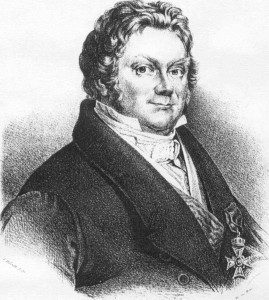
In 1817, the Swedish chemist and one of the founders of Karolinska Institutet, Jacob Berzelius, initiated the field of selenium research:
”The Discovery of Selenium”
Berzelius and Gahn met at Gripsholm in August 1817. Berzelius spent more than one month there, studying, inter alia, technical issues related to the production of sulfuric acid and nitric acid (aqua fortis). The former owner of the factory, M. Bjuggren, had noted that a reddish sludge occurred in the lead chamber, only when pyrite (an iron sulfide) from the mine in Falun was used. The sludge was believed to be an arsenic compound and hence the Falun pyrite was avoided. However, Gahn and Eggertz both came from Falun and considered it interesting and important to use Falun pyrite. Therefore, Gahn and Berzelius—being the experts—tried to analyze the reddish sludge. By roasting 200 kg of sulfur they obtained about 3 g of a precipitate. Their subsequent chemical analysis of the sample indicated the possible presence of tellurium (discovered in mines in Transylvania in the 1780s). However, Berzelius doubted this result since tellurium had never been found in minerals from Falun. Nevertheless, he wrote about tellurium in letters to his close friends Alexandre Marcet and H.G. Trolle Wachtmeister in 1817. In early 1818, Berzelius repeated the experiments in his Stockholm laboratory and concluded that the sludge must contain a new element.
The new element had properties of a metal, and was similar to sulfur, initially suggesting it to be a new species of sulfur. In its metallic state, it had a brilliant grayish lustre. When heated by a candle using blowpipe analysis, it burned with an azure-blue flame and emitted a strong odor of horseradish, typical of tellurium. This smell may initially have fooled Berzelius and Gahn.
Klaproth had assigned tellurium (Latin: tellus, earth) to Müller von Rechenstein’s new element in 1784. Berzelius chose the name selenium (Greek: selene, moon) for the new element, noting its resemblance to tellurium.”
From
”Berzelius’ Discovery of Selenium”
by Jan Trofast
Reprinted by permission of the IUPAC from Chem. Int., Vol. 33 No. 5, September-October 2011
related to the production of sulfuric acid and nitric acid (aqua fortis). The former owner of the factory, M. Bjuggren, had noted that a reddish sludge occurred in the lead chamber, only when pyrite (an iron sulfide) from the mine in Falun was used. The sludge was believed to be an arsenic compound and hence the Falun pyrite was avoided. However, Gahn and Eggertz both came from Falun and considered it interesting and important to use Falun pyrite. Therefore, Gahn and Berzelius—being the experts—tried to analyze the reddish sludge. By roasting 200 kg of sulfur they obtained about 3 g of a precipitate. Their subsequent chemical analysis of the sample indicated the possible presence of tellurium (discovered in mines in Transylvania in the 1780s). However, Berzelius doubted this result since tellurium had never been found in minerals from Falun. Nevertheless, he wrote about tellurium in letters to his close friends Alexandre Marcet and H.G. Trolle Wachtmeister in 1817. In early 1818, Berzelius repeated the experiments in his Stockholm laboratory and concluded that the sludge must contain a new element.
The new element had properties of a metal, and was similar to sulfur, initially suggesting it to be a new species of sulfur. In its metallic state, it had a brilliant grayish lustre. When heated by a candle using blowpipe analysis, it burned with an azure-blue flame and emitted a strong odor of horseradish, typical of tellurium. This smell may initially have fooled Berzelius and Gahn.
Klaproth had assigned tellurium (Latin: tellus, earth) to Müller von Rechenstein’s new element in 1784. Berzelius chose the name selenium (Greek: selene, moon) for the new element, noting its resemblance to tellurium.”
From
”Berzelius’ Discovery of Selenium”
by Jan Trofast
Reprinted by permission of the IUPAC from Chem. Int., Vol. 33 No. 5, September-October 2011
Please see this link for information.

